Soluble extracts from Helicobacter pylori induce dome formation in polarized intestinal epithelial monolayers in a laminin-dependent manner
- PMID: 12819097
- PMCID: PMC162010
- DOI: 10.1128/IAI.71.7.4067-4078.2003
Soluble extracts from Helicobacter pylori induce dome formation in polarized intestinal epithelial monolayers in a laminin-dependent manner
Abstract
Helicobacter pylori colonizes the stomach at the interface between the mucus layer and the apical pole of gastric epithelial cells. A number of secreted and shed products from the bacteria, such as proteins and lipopolysaccharide, are likely to have a role in the pathogenesis at the epithelial level. To determine the physiological response of transporting polarized epithelia to released soluble factors from the bacterium, we used the T84 cell line. Monolayers of T84 cells were exposed to soluble extracts from H. pylori. The extracts induced rapid "dome" formation as well as an immediate decrease in transepithelial electrical resistance. Domes are fluid-filled blister-like structures unique to polarized epithelia. Their formation has been linked to sodium-transporting events as well as to diminished adherence of the cells to the substrate. H. pylori-induced dome formation in T84 monolayers was exacerbated by amiloride and inhibited by ouabain. Furthermore, it was associated with changes in the expression of the laminin binding alpha 6 beta 4 integrin and the 67-kDa laminin receptor. Domes formed primarily on laminin-coated filters, rather than on fibronectin or collagen matrices, and their formation was inhibited by preincubating the bacterial extract with soluble laminin. This effect was specific to H. pylori and independent of the urease, vacA, cagA, and Lewis phenotype of the strains. These data indicate that released elements from H. pylori can alter the physiological balance and integrity of the epithelium in the absence of an underlying immune response.
Figures
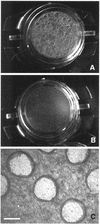
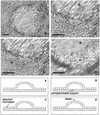




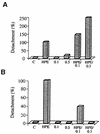
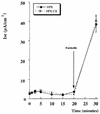
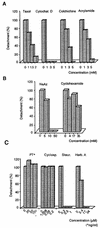

Similar articles
-
Effect of Helicobacter pylori on polymorphonuclear leukocyte migration across polarized T84 epithelial cell monolayers: role of vacuolating toxin VacA and cag pathogenicity island.Infect Immun. 2000 Sep;68(9):5225-33. doi: 10.1128/IAI.68.9.5225-5233.2000. Infect Immun. 2000. PMID: 10948148 Free PMC article.
-
Helicobacter pylori disrupts epithelial barrier function in a process inhibited by protein kinase C activators.Infect Immun. 1998 Jun;66(6):2943-50. doi: 10.1128/IAI.66.6.2943-2950.1998. Infect Immun. 1998. PMID: 9596771 Free PMC article.
-
Adhesion of Helicobacter pylori to polarized T84 human intestinal cell monolayers is pH dependent.Infect Immun. 1996 Sep;64(9):3827-32. doi: 10.1128/iai.64.9.3827-3832.1996. Infect Immun. 1996. PMID: 8751935 Free PMC article.
-
The role of lipopolysaccharide in Helicobacter pylori pathogenesis.Aliment Pharmacol Ther. 1996 Apr;10 Suppl 1:39-50. doi: 10.1046/j.1365-2036.1996.22164004.x. Aliment Pharmacol Ther. 1996. PMID: 8730258 Review.
-
[Pathogenesis of Helicobacter pylori infection--bacterium and host relationship].Srp Arh Celok Lek. 2004 Sep-Oct;132(9-10):340-4. doi: 10.2298/sarh0410340s. Srp Arh Celok Lek. 2004. PMID: 15794058 Review. Serbian.
Cited by
-
Antisecretory factor peptide AF-16 inhibits the secreted autotransporter toxin-stimulated transcellular and paracellular passages of fluid in cultured human enterocyte-like cells.Infect Immun. 2015 Mar;83(3):907-22. doi: 10.1128/IAI.02759-14. Epub 2014 Dec 22. Infect Immun. 2015. PMID: 25534938 Free PMC article.
-
Optimizing culture conditions of a porcine epithelial cell line IPEC-J2 through a histological and physiological characterization.Cytotechnology. 2011 Aug;63(4):415-23. doi: 10.1007/s10616-011-9362-9. Epub 2011 May 29. Cytotechnology. 2011. PMID: 21626283 Free PMC article.
-
Characterization of a porcine intestinal epithelial cell line for in vitro studies of microbial pathogenesis in swine.Histochem Cell Biol. 2006 Mar;125(3):293-305. doi: 10.1007/s00418-005-0067-z. Epub 2005 Oct 8. Histochem Cell Biol. 2006. PMID: 16215741
-
Sequence and apoptotic activity of VacA cytotoxin cloned from a Helicobacter pylori Thai clinical isolate.Biomed Res Int. 2014;2014:398350. doi: 10.1155/2014/398350. Epub 2014 Apr 2. Biomed Res Int. 2014. PMID: 24963483 Free PMC article.
References
-
- Ardini, E., E. Tagliabue, A. Magnifico, S. Buto, V. Castronovo, M. I. Colhaghi, and S. Menard. 1997. Co-regulation and physical association of the 67-kDa monomeric laminin receptor and the α6β4 integrin. J. Biol. Chem. 272:2342-2345. - PubMed
-
- Ashorn, M., F. Cantet, K. Mayo, and F. Megraud. 2000. Cytoskeletal rearrangements induced by Helicobacter pylori strains in epithelial cell culture: possible role of the cytotoxin. Dig. Dis. Sci. 45:1774-1780. - PubMed
-
- Bradford, M. M. 1976. A rapid and sensitive method for the quantitation of microgram quantities of protein utilizing the principle of protein-dye binding. Anal. Biochem. 72:248-254. - PubMed
Publication types
MeSH terms
Substances
LinkOut - more resources
Full Text Sources
Molecular Biology Databases

